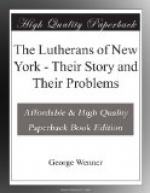Nor does the Sunday School reach all the children. Attendance is voluntary, and hence there is no guarantee that all the children of school age will obtain any instruction, to say nothing of graded and systematic instruction, taking account of the entire school life, and holding in mind the ultimate object of instruction, the preparation of children for full membership in the church. But this is one of the first duties of the churches, to look after all their children with this end in view.
As a supplement and an aid the Sunday School has untold possibilities of usefulness. But all its merits and advantages cannot close our eyes to the fact that it does not and cannot meet the chief requirement of the Christian school, the systematic preparation of all the children for the duties of church membership. In this work the church cannot shirk her responsibility. Her very existence depends upon it.
Recognizing this obligation some of our churches maintain
the Parochial School. Thirty churches out of
one hundred and fifty are making a heroic effort to
be loyal to their ideals. The total number of
pupils is 1,612. In other words, out of 42,106
children in attendance at Sunday School only 4 per
cent. get instruction in religion through the Parochial
School. So far as numbers show it would seem to
be a failure. But one cannot always judge from
the outward appearance. Eight of these parochial-school
churches report fifty of their sons in the ministry.*
Some of the pastors
failed to send me reports on this point, but I
have been credibly informed that within twelve years,
ten of these churches sent sixty of their sons into
the ministry.
In view of such a result who would dare to say anything in disparagement of the Parochial School? Perhaps its friends may some time see their way clear to secure greater efficiency by establishing three or four schools in place of the thirty, and thus relieve the individual congregations of a serious tax upon their resources.
Some of our churches have Saturday schools and classes in religion on other week days. The total number of pupils reported in these classes, including the members of confirmation classes, is 5,711. Add to these the 1,612 pupils of the parochial schools, some of whom have already been counted in the confirmation classes, and we have at most 7,323 children obtaining instruction in religion on week days, 17 per cent. of the number of those in attendance at Sunday School.




